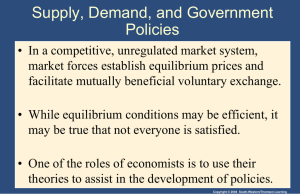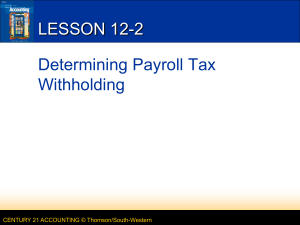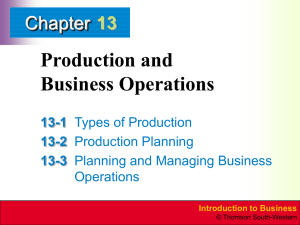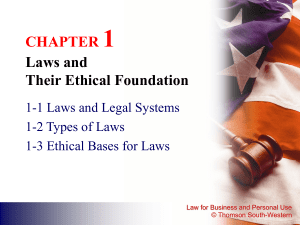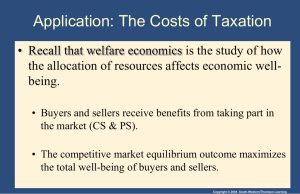Chapter Nine
advertisement
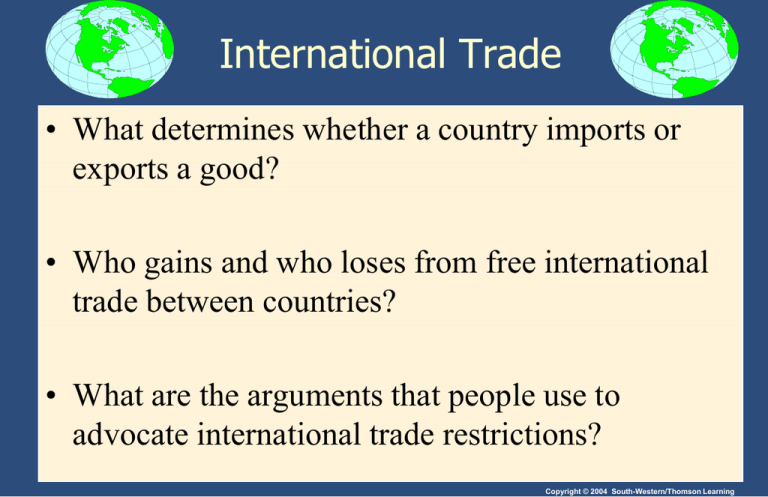
International Trade • What determines whether a country imports or exports a good? • Who gains and who loses from free international trade between countries? • What are the arguments that people use to advocate international trade restrictions? Copyright © 2004 South-Western/Thomson Learning Interdependence & Gains from Trade • Remember, economics is the study of how societies produce and distribute goods in an attempt to satisfy the wants and needs of its members. • Voluntary trade creates wealth! • Bag Game, Movies, Other Stuff… Copyright © 2004 South-Western/Thomson Learning THE DETERMINANTS OF TRADE • Equilibrium Without International Trade • A country is isolated from rest of the world and produces steel. • The market for steel consists of the buyers and sellers in the country (domestic). • There is no import or export of steel. Copyright © 2004 South-Western/Thomson Learning Figure 1The Equilibrium without International Trade Price of Steel Domestic supply Consumer surplus Equilibrium price Producer surplus Domestic demand 0 Equilibrium quantity Quantity of Steel Copyright © 2004 South-Western The World Price and Comparative Advantage • The effects of free international trade can be shown by comparing the domestic price of a good without trade and the world price of the good. • The world price refers to the price that prevails in the world market for that good. Copyright © 2004 South-Western/Thomson Learning The World Price and Comparative Advantage • With international trade, will a country be an importer or exporter of steel? • If a country has a comparative advantage, the domestic price will be below the world price, and the country will be an exporter of the good. • If the country has a comparative disadvantage, the domestic price will be higher than the world price, and the country will be an importer of the good. Copyright © 2004 South-Western/Thomson Learning The Gains and Losses of an Exporting Country • International Trade in an Exporting Country • World price of steel > domestic price of steel. • Domestic producers increase production as the price moves up to the world price. • Domestic consumers decrease consumption as the price moves up to the world price. • The excess supply (surplus) will be exported to willing buyers in another country. Copyright © 2004 South-Western/Thomson Learning Figure 3 How Free Trade Affects Welfare in an Exporting Country Price of Steel Consumer surplus before trade Price after trade Exports A B Price before trade World price D C Producer surplus before trade 0 Domestic supply Domestic demand Quantity of Steel Copyright © 2004 South-Western How Free Trade Affects Welfare in an Exporting Country Copyright © 2004 South-Western/Thomson Learning THE WINNERS AND LOSERS FROM TRADE • The analysis of an exporting country yields two conclusions: • Domestic producers of the good are better off, and domestic consumers of the good are worse off. • Trade raises the economic well-being of the nation as a whole because the gains of producers exceed the losses of consumers. Copyright © 2004 South-Western/Thomson Learning The Gains and Losses of an Importing Country • International Trade in an Importing Country • World price of steel < domestic price of steel. • Domestic producers decrease production as the price moves down to the world price. • Domestic consumers increase consumption as the price moves down to the world price. • The excess demand (shortage) will be satisfied by imports from willing sellers in another country. Copyright © 2004 South-Western/Thomson Learning Figure 5 How Free Trade Affects Welfare in an Importing Country Price of Steel Consumer surplus after trade Domestic supply A Price before trade Price after trade 0 B C D Imports Producer surplus after trade World price Domestic demand Quantity of Steel Copyright © 2004 South-Western How Free Trade Affects Welfare in an Importing Country Copyright © 2004 South-Western/Thomson Learning THE WINNERS AND LOSERS FROM TRADE • The analysis of an importing country yields two conclusions • Domestic producers of the good are worse off, and domestic consumers of the good are better off. • Trade raises the economic well-being of the nation as a whole because the gains of consumers exceed the losses of producers. Copyright © 2004 South-Western/Thomson Learning The Effects of a Tariff • A tariff is a tax on goods produced abroad and sold domestically. • Tariffs raise the price of imported goods above the world price by the amount of the tariff. Copyright © 2004 South-Western/Thomson Learning Figure 6 The Effects of a Tariff Price of Steel Domestic supply A Deadweight Loss B Price with tariff Price without tariff 0 C D E G Tariff F Imports with tariff Q S Q S Domestic demand Q Imports without tariff D Q D World price Quantity of Steel Copyright © 2004 South-Western The Effects of a Tariff Copyright © 2004 South-Western/Thomson Learning The Effects of a Tariff • Tariffs reduce imports and move the domestic market closer to its equilibrium before trade. • Domestic production increases while domestic consumption decreases. • Tariffs reduce total well-being (total surplus) in the market by an amount called deadweight loss. Copyright © 2004 South-Western/Thomson Learning The Lessons for Trade Policy • Import quotas limit the quantity of a good that can be produced abroad and sold domestically. • In the domestic market both tariffs and quotas .... • raise prices and reduce imports. • increase production and decrease consumption. • increase welfare of producers and reduce welfare of consumers. • cause deadweight loss. Copyright © 2004 South-Western/Thomson Learning The Lessons for Trade Policy • Other Benefits of International Trade • Increased variety of goods • Increased competition • Enhanced flow of ideas Copyright © 2004 South-Western/Thomson Learning THE ARGUMENTS FOR RESTRICTING TRADE • • • • Jobs National Security Infant Industry Unfair Competition Copyright © 2004 South-Western/Thomson Learning Trade Agreements and the World Trade Organization • Unilateral: when a country removes its trade restrictions on its own. • Multilateral: a country reduces its trade restrictions while other countries do the same. Copyright © 2004 South-Western/Thomson Learning Trade Agreements and the World Trade Organization • NAFTA • The North American Free Trade Agreement (NAFTA) is an example of a multilateral trade agreement. • In 1993, NAFTA lowered the trade barriers among the United States, Mexico, and Canada. Copyright © 2004 South-Western/Thomson Learning Trade Agreements and the World Trade Organization • GATT • The General Agreement on Tariffs and Trade (GATT) refers to a continuing series of negotiations among many of the world’s countries with a goal of promoting free trade. • GATT has successfully reduced the average tariff among member countries from about 40 percent after WWII to about 5 percent today. Copyright © 2004 South-Western/Thomson Learning Punch Line • If you care about someone’s well-being, trade with them. • Why? • Because trade creates well-being! Copyright © 2004 South-Western/Thomson Learning Summary • The effects of free international trade can be determined by comparing the domestic price without trade to the world price. • A low domestic price indicates that the country has a comparative advantage in producing the good and the country will become an exporter. • A high domestic price indicates that the country has a comparative disadvantage in producing the good and the country will become an importer. Copyright © 2004 South-Western/Thomson Learning Summary • If a country moves to international trade and exports a good, producers of the good are better off, while consumers are worse off. • When a country moves to international trade and imports a good, consumers of the good are better off, while producers are worse off. • In each case, the gains outweigh the losses. Copyright © 2004 South-Western/Thomson Learning Summary • A tariff—a tax on imports—moves a market closer to the equilibrium than would exist before trade, and thus reduces well-being (total surplus). • Import quotas will generally have effects similar to those of tariffs. Copyright © 2004 South-Western/Thomson Learning Summary • There are various arguments for restricting trade: protecting jobs, defending national security, helping infant industries, preventing unfair competition, and responding to foreign trade restrictions (retaliation). • However, most economists believe that free international trade is generally the better policy. Copyright © 2004 South-Western/Thomson Learning


